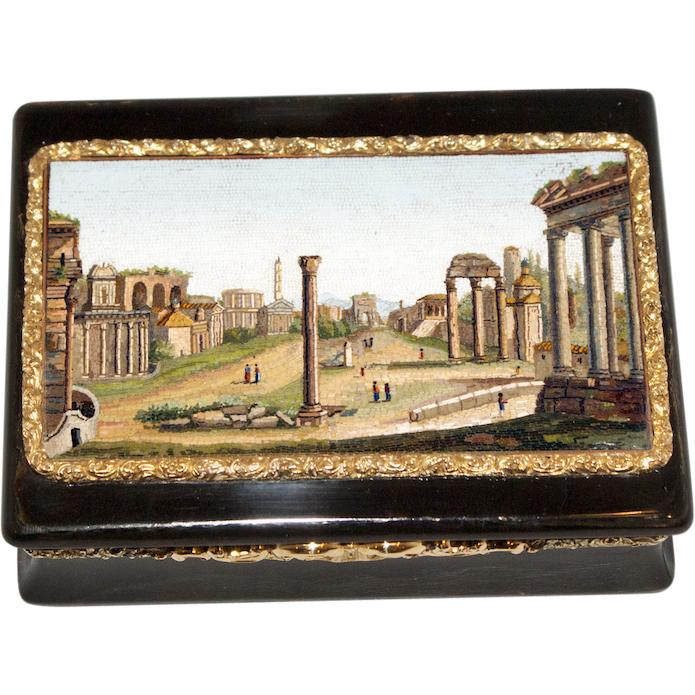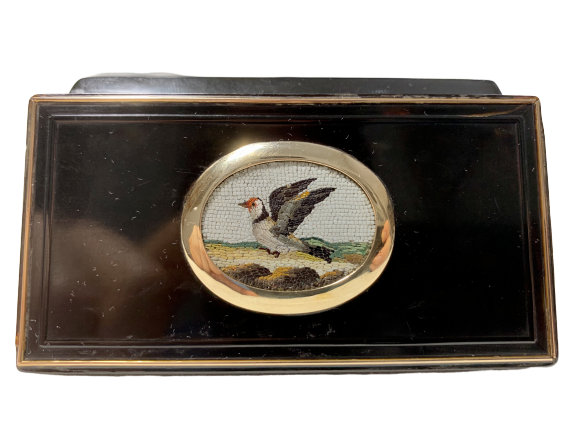
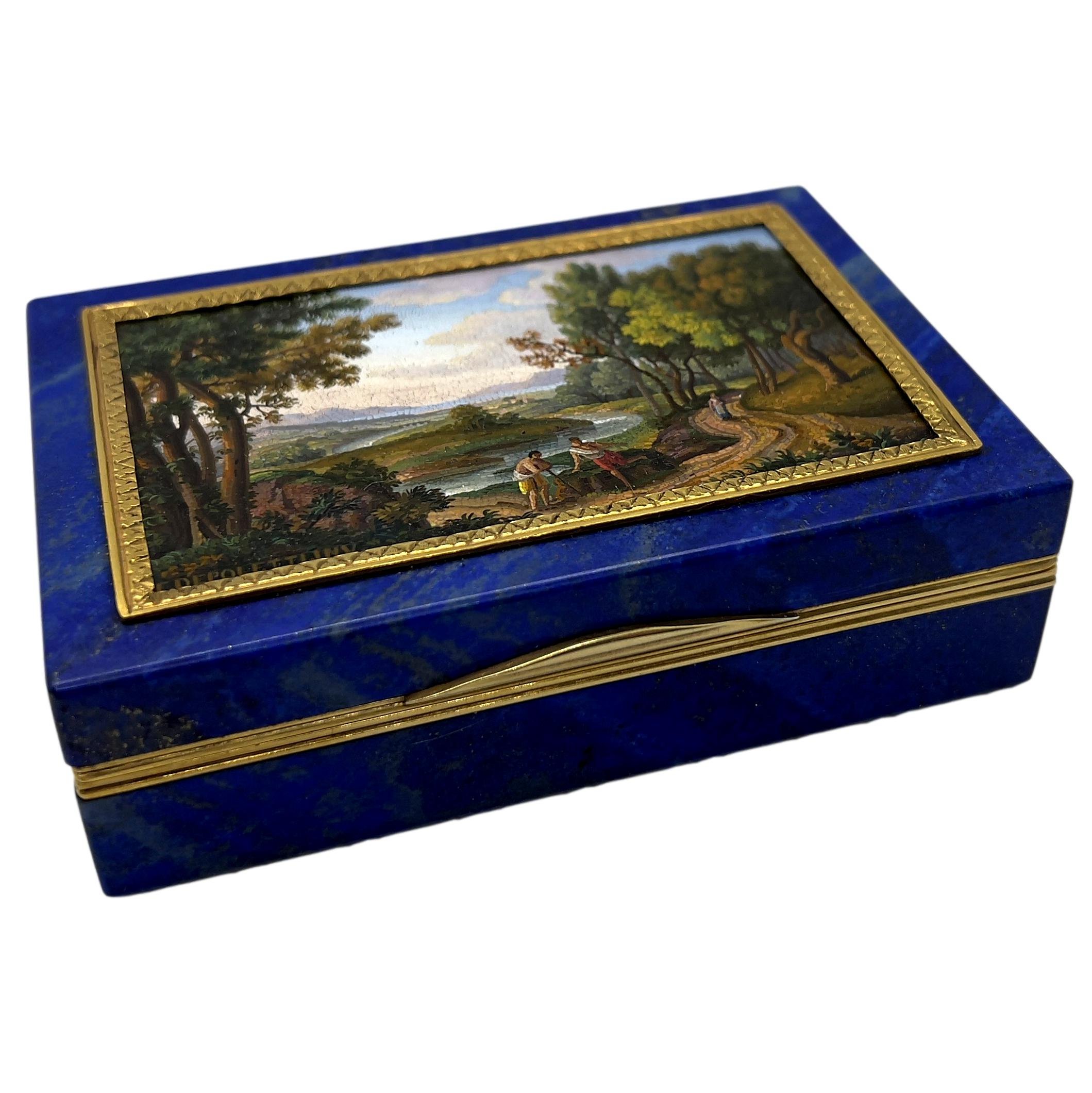

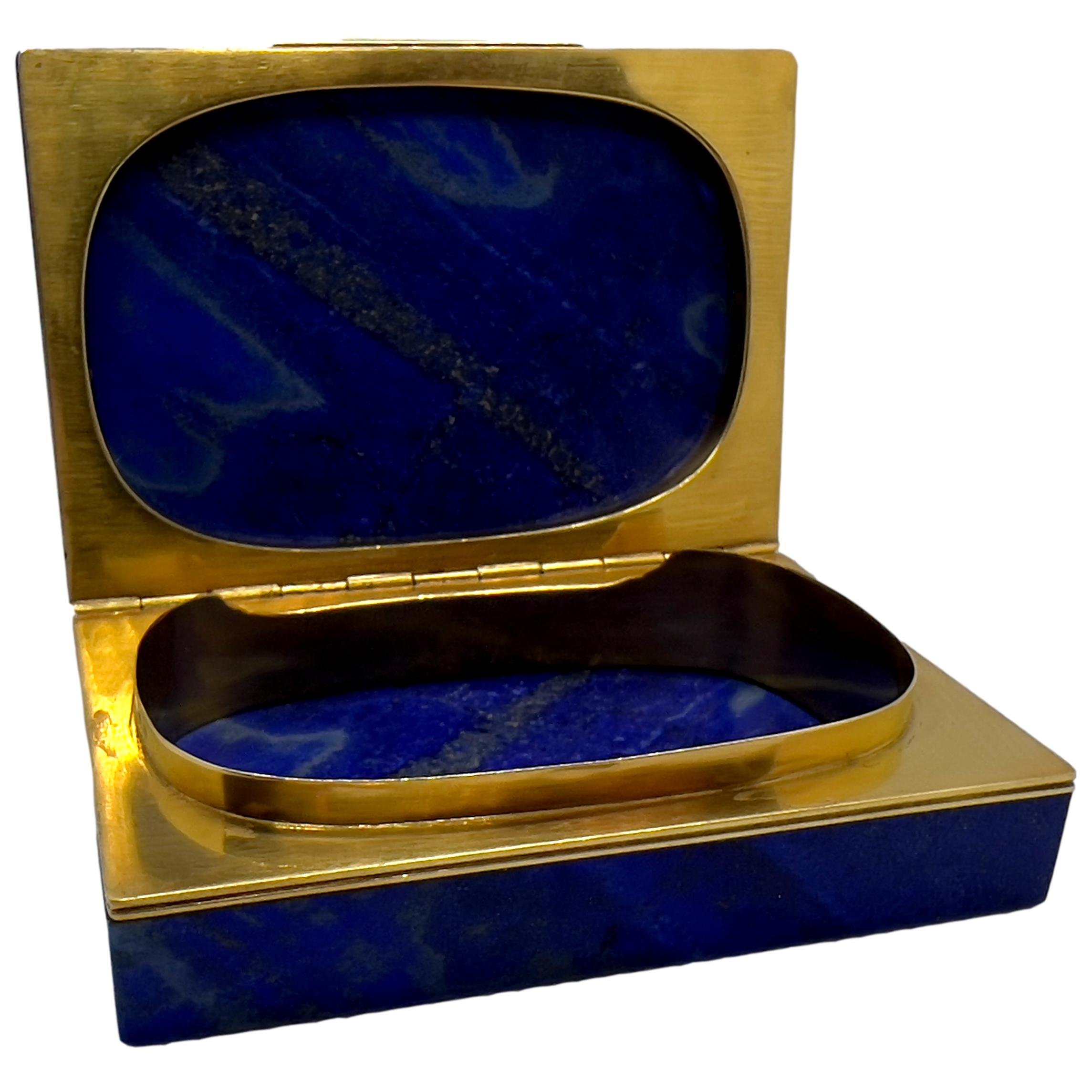
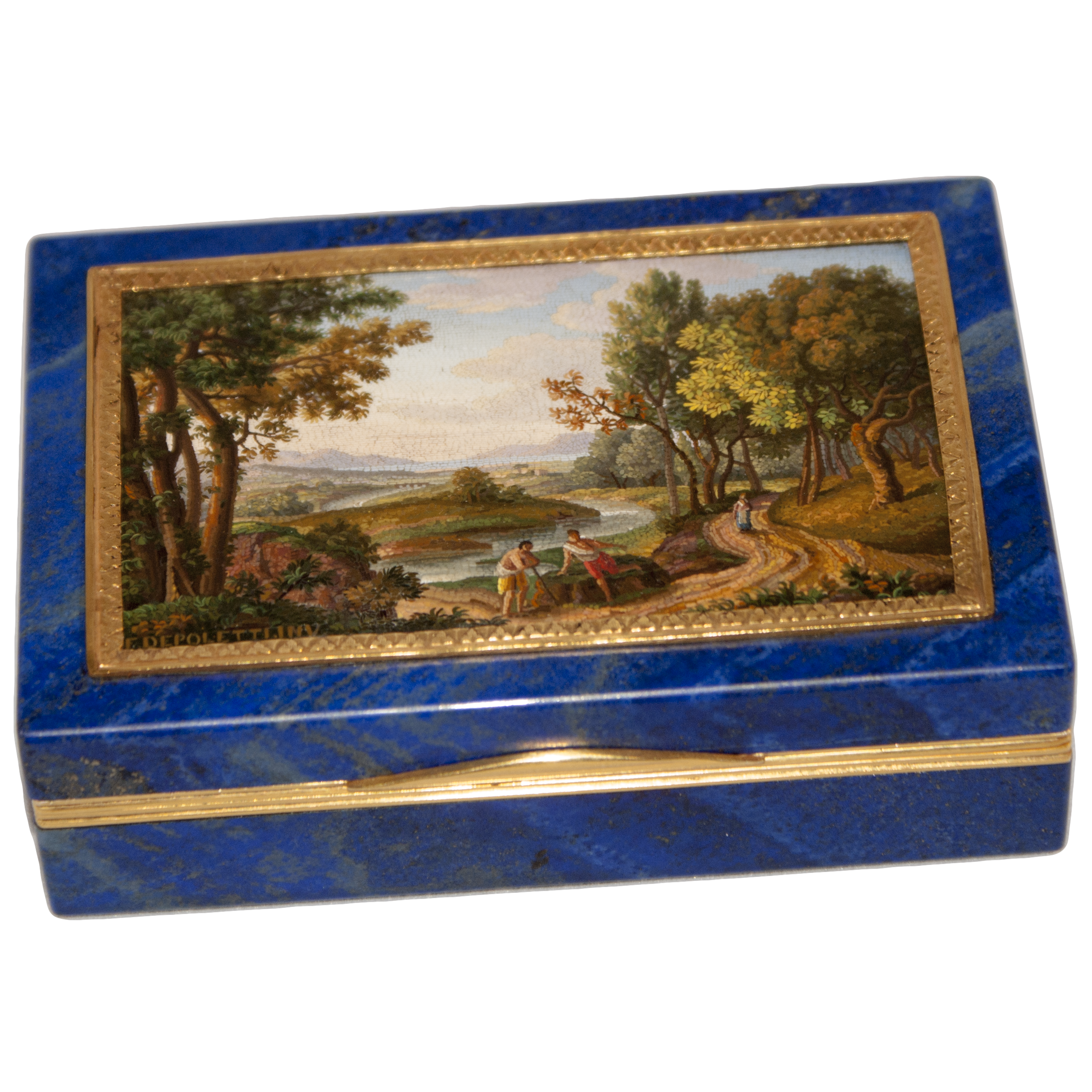

Box micromosaic signed DEPOLETTI
A rare museum quality micromosaic plaque set on copper representing an arcadian landscape depicting a view of a trail along a river with two men resting and a woman approaching, flanked by trees and with a lake and a bridge surrounded by hills in the distance. Possibly from a painting in the manner of Claude Lorrain or Poussin.
Signed lower left F. DEPOLETTI INV. for Francesco Depoletti o De Poletti (1779 - 1854) invented. Mounted on the hinged top of lapislazzuli hardstone box with silver gilt mountings. Papal hallmark for the city of Rome and of the goldsmith Giacomo Sirletti (1755-1837 active from 1811).
Dimension of the micromosaic cm 5 x 8.5 ca - the box cm 7 x 10 x 3h
Excellent condition commensurate with age.
Box micromosaic signed DEPOLETTI
A rare museum quality micromosaic plaque set on copper representing an arcadian landscape depicting a view of a trail along a river with two men resting and a woman approaching, flanked by trees and with a lake and a bridge surrounded by hills in the distance. Possibly from a painting in the manner of Claude Lorrain or Poussin.
Signed lower left F. DEPOLETTI INV. for Francesco Depoletti o De Poletti (1779 - 1854) invented. Mounted on the hinged top of lapislazzuli hardstone box with silver gilt mountings. Papal hallmark for the city of Rome and of the goldsmith Giacomo Sirletti (1755-1837 active from 1811).
Dimension of the micromosaic cm 5 x 8.5 ca - the box cm 7 x 10 x 3h
Excellent condition commensurate with age.
DEPOLETTI (De Poletti), Francesco. - Born in Rome, Apr. 25, 1779.
He soon revealed a happy disposition for the fine arts and, of versatile genius, devoted himself successfully to painting, mosaics, restoration of ancient ceramics, and antiques. According to Visconti, who left an extensive epitome of his life in the obituary that appeared in the 1854 Giornale di Roma, he learned the principles of drawing and painting in the studio of Pompeo Batoni. But rather than a direct alumnus it is more appropriate to speak of a training in the Batonian ways, held in high regard by the last eighteenth-century generation of painters, since Depoletti was only eight years old when the famous painter died in 1787. To what extent he had made Batoni's formal values his own, however, is impossible to determine, as his pictorial work is completely unknown at present. P, known only that he specialized in landscape painting, reporting great praise for it.
Probably at the close of the 1700s he approached the study of mosaic technique, taking a particular interest in minute mosaic, an artistic field then in great expansion.
Taking advantage of the possibility of spinning enamel, Roman artists, starting with Giacomo Raffaelli, who had been active in this field since 1775, spread an entirely original art. By reducing the enamel into very thin rods and subsequently obtaining from them tesserae of tiny proportions, they achieved the result of being able to spread the mosaic even on surfaces of a few centimeters, equaling the effects of the miniature. The possibilities for application turned out to be manifold, and the proliferation of Roman workshops specializing in minute mosaics constitutes a confirmation of the appreciation paid by contemporaries to the new artistic genre.
Moroni mentions Depoletti twice, recalling him first among the most distinguished mosaic artists active in Rome in the early 19th century, and later among the owners of the city's most flourishing workshops. His studio was located at No. 32 Via Condotti, in an area of strong tourist appeal. Two mosaics by Depoletti, signed and dated 1818 and 1819, have been published by González Palacios (1982), who points to them in a private collection.
They are reproductions of two famous landscapes by Claude Lorrain from the Doria Gallery in Rome. Visconti speaks of these small paintings, stating that they were then in Florence, in the villa of Prince A. Demidoff, whose father had commissioned them from Depoletti. Visconti also mentions three small paintings, exhibited at the first Capitoline exhibition of Roman arts and industry held in 1810, depicting A Village taken from Salvator Rosa; a copy of Guercino's Aurora; and a view of the Sepulchre of the Plauzi, taken from an original by A. De Angelis. For these works Depoletti was awarded the first-class silver medal. News of the award was also published in the Giornale del Campidoglio of September 1, 1810.
Later the artist executed a copy of Domenichino's The Hunting of Diana from the Galleria Borghese in Rome, which Visconti says he purchased along with another work, The Shield of Achilles, from Lord Bristol (in those years, Frederich William Hervey, fifth Earl of Bristol). Depoletti's The Shield of Achilles, a work also recalled by Guattani (1819), was probably inspired by the famous round mosaic table depicting the same theme, executed at the Vatican Mosaic Studio between 1812 and 1818, donated in 1825 by Leo XII to Charles X king of France and now in the Versailles Museum. The last mosaic recorded by Visconti, after 1819, is A Country, described as being of fair size, taken from an original by the Roman G. Gabrielli and owned at the time by Card. G. Antonelli, secretary of state to the pontiff and prefect of the Sacred Apostolic Palaces.
In 1824, probably toward the end of the year. the Depoletti moved to Naples with his family, of whom there is no other information, called by Ferdinand I to work on mosaic pictures and friezes for the church of S. Francesco di Paola that was being built, and to organize a school of mosaic on the type of the one active in Rome in the Vatican. These programs were not followed up because of the sovereign's death on January 4, 1825. However, Depoletti was able to gain useful experience from his Neapolitan sojourn by coming into contact with one of the most skilled restorers in the Bourbon Museum, Daniele Sabano, and learning from him the technique of restoring Etruscan vases, a discipline that was still not widespread in Rome where it was the prerogative of one Giovanni Cresceni, also a Neapolitan, who practiced it in the most absolute secrecy.
Depoletti immediately benefited from this study as, coinciding with his return to Rome, important discoveries of Etruscan pottery occurred at Canino, Corneto, Ceri and other centers of maritime Etruria. The art he learned in Naples made Depoletti the artist most in demand for the restoration of excavated finds. He worked for the Gregorian Museum in Rome and was then for the same purpose in Paris, London, Berlin, Munich, and Petersburg. These trips also fostered his work as an antiquarian and at the same time allowed him to become acquainted with European artistic culture.
Depoletti died in Rome on Sept. 15, 1854.
In addition to praise for his achievements in his artistic activity, Visconti also gave Depoletti recognition for the self-sacrifice with which he carried out the task of deputy for public safety for the Campo Marzio district during the cholera epidemic that struck Rome in 1837. For such services the artist was awarded the gold medal by Gregory XVI.
[by Maria Grazia Branchetti Buonocuore - Biographical Dictionary of Italians - Volume 39 (1991)]



